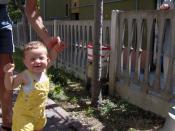I.
Life-Span Perspective
A.
Historical - view of children and child development has changed throughout history
1. Aries used samples of art to conclude life development consisted of only two phases:
* Infancy and adulthood
* Results biased toward only studying European Aristocrats
2. Egyptians, Grecians and Romans held rich conceptions of children's development
3. Three Philosophical Views
* Original Sin (Middle Ages) - children are inherently evil and societal constraints and salvation are necessary for children to become mature adults
* Tabula rasa (17th Century/John Locke) - child is a blank tablet upon which experience writes
* Innate Goodness (18th Century/Jean Rousseau) - children are basically good and should be allowed to grow naturally, without constraints from parents or society
4. Childhood currently viewed as unique period of life that creates the foundation for adult years
* special time of growth and change
* resources invested in caring for and educating our children
Child Labor Laws
Juvenile Justice
Governmental provisions for helping families in need of social welfare
5. Research does not support G. Stanley Hall's view - adolescence period of "storm and stress"
* 1988 Cross Cultural - most adolescents have positive self-images
* Characterized as competent, happy, enjoying life, confident in sexuality and ability to cope effectively with stress
6. Adolescence - developmental period that is characterized by physical, social and legal identity
*
Industrial revolution, child labor laws, juvenile justice and compulsory education laws
7. Developmental changes occur throughout adulthood
* increasing average life expectancies - study of aging
* elimination of mandatory retirement requirements - value on contributions of elderly
B.
Characteristics of Life-Span development
1. Life-long
2. Multi-dimensional - Biological, Cognitive and Social
3. Multi-directional - some dimensions increase with age and some decrease
*
born with more neurons/hooked up better with age
4. Plasticity - development can take many paths
5. Historically embedded - development affected by historical events
6. Multidisciplinary - studied by many ( psychologists, biologists, sociologists, anthropologists)
7. Contextual - changing beings in a changing world
* normative age-graded influences - similar in a particular age group (biological/puberty, menopause) (environmental/start formal education @ 5 or 6)
* normative history-graded influences - generational influences (Great Depression)
* nonnormative life events - unusual occurrences (fire, accident, natural disaster)
C.
Prominent Concerns
1. Health and Well-being
2. Parenting and Education
3. Sociocultural Contexts (American Cultural Tapestry - context, culture, ethnicity and gender)
4. Social Policy (Generational inequity - older population doing better at the expense of younger)
II.
Periods of Development - Bernice Neugarten has argued that ours is an increasingly age-irrelevent society
A. Prenatal (conception to birth)
B. Infancy (birth to 24 months)
C. Early Childhood (preschool years)
D. Middle and Late Childhood (elementary school years)
E. Adolescence (puberty to 18-21)
F. Early Adulthood (late teens through early 30's)
G. Middle Adulthood (35-45 through 50's)
H. Late Adulthood (60's to death)
III.
Developmental Issues
A. Maturation and Experience (Nature vs. Nurture)
1. Maturation - orderly sequence of changes dictated by our individual genetic blueprints
2. How much nature and how much nurture is responsible for development?
B. Continuity and Discontinuity
1. Continuity - gradual cumulative change from conceptive onward
2. Discontinuity - distinct stages and qualitative changes
C. Stability and Change
1. Stability - older version of his or her younger self
2. Change - individual becomes different with age
3. Dialectical model - emphasizes continual change resulting from an individual's action and reaction to social and historical conditions
4. Extent to which experiences early or later in life play a prominent role in development


